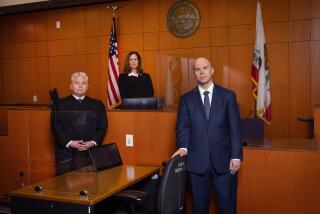Surveys Reveal Court Gains on Felony Backlog
The Los Angeles County Superior Court, responding to charges that its foot-dragging on criminal cases causes overcrowding in the county’s jails, Thursday released surveys showing that the proportion of jail inmates awaiting trial is actually decreasing and that the court handles cases faster than most urban courts nationwide.
A study begun by Frank S. Zolin, the court’s executive officer, when jail overcrowding became a major concern three years ago, shows that although the countywide jail population rose from 17,172 in June, 1985, to 22,101 last June, the number of felony defendants awaiting trial remained fairly stable--3,580, or 21% of the total three years ago to 3,770, or 17% of the total last June.
Zolin also released a survey by the National Center of State Courts showing that Los Angeles processes criminal cases faster than most of 18 other urban courts the center studied.
The processing time, according to the national survey, ranged from 31 days in Detroit to 332 days in Boston, with a median of 95.4 days.
Los Angeles’ average disposition time for felony cases last year was 60 days.
“The facts clearly show that the court case processing has not contributed to jail overcrowding,” said Richard P. Byrne, presiding judge of the 226-judge Superior Court, in releasing the surveys.
“The number of Los Angeles Superior Court in-custody defendants as a percentage of the total jail population has dropped,” Zolin added. “This strongly indicates that the Superior Court is not causing any increase in pre-conviction in-custody defendants proportionate to jail population growth and resultant jail overcrowding.”
The surveys were filed in U.S. District Court late Wednesday in response to an attempt by the American Civil Liberties Union to intervene in a pending suit filed last year by the Los Angeles County Bar Assn. over civil court delays.
U.S. District Judge David V. Kenyon last week rejected an ACLU move seeking quick resolution of its claims that the Superior Court’s inefficiency, liberal granting of postponements and reluctance to increase criminal courtrooms cause inmates awaiting trial to remain in overcrowded jails longer than necessary. The request to intervene has not been ruled on.
Sheriff Sherman Block has been authorized by U.S. District Judge William P. Gray since May, in separate litigation by the ACLU over jail overcrowding, to release enough inmates early to limit overall jail population to about 22,319. The rated total capacity of all county jails is 12,556.
Zolin, a member of the Los Angeles County Jail Overcrowding Task Force since 1985, estimated that it will be two or three more years before the Sheriff’s Justice Data System, which tracks jail inmates, can be expanded to identify causes of overcrowding.
“Jail overcrowding,” Byrne suggested Thursday, “is most likely caused by insufficient jail capacity, the increased number of sentenced inmates due to tougher superior and municipal court sentencing practices . . . increased crime rates, and any number of other potential sources and social factors.”
In answer to the ACLU’s charge that the court drags its feet in processing criminal cases, Zolin said his study showed that the age of felony cases has also dropped during the last three years. In June, 1985, he said, 53% of felony cases in Los Angeles County were more than 60 days old, but last June, that figure was down to 29%.
Under California law, a defendant can demand trial within 60 days of being formally charged. The ACLU has claimed that county jails usually have more than 1,000 inmates who have been waiting for trials more than six months and “hundreds” who have waited more than a year.
Zolin and Byrne also denied that the court unnecessarily grants postponements.
“Superior Court judges grant continuances only on a showing of good cause by defense counsel or prosecutors,” said Byrne. “Our continuance practices are not delaying trials or causing jail overcrowding.”
Zolin, the court’s executive officer since 1969, also disputed the ACLU’s claim that the court had balked at expansion.
“Since 1970, the Superior Court has made 13 formal requests to Los Angeles County and appropriate officials of the State of California for additional judgeships and court facilities,” he stated.
JAIL TIME
A study by the Los Angeles Superior Court over the past three years indicates that, although the total population of inmates in county jails has increased substantially, the number of felony defendants in jail while awaiting disposition of their cases has remained fairly stable and the percentage has actually decreased.
1985
Awaiting Trial: 21%
1988
Awaiting Trial: 17%
Source: Los Angeles Superior Court
More to Read
Sign up for Essential California
The most important California stories and recommendations in your inbox every morning.
You may occasionally receive promotional content from the Los Angeles Times.









